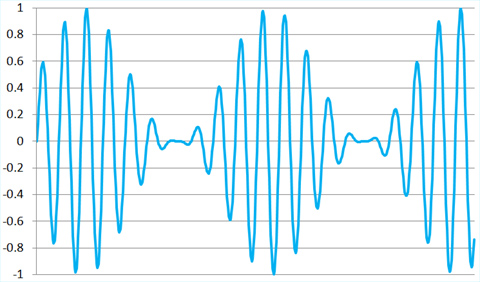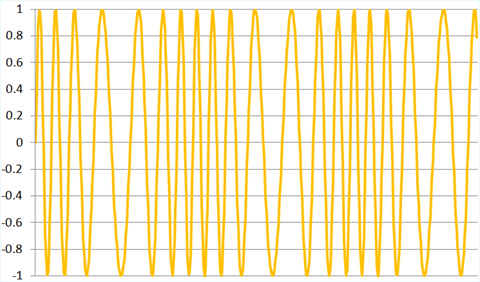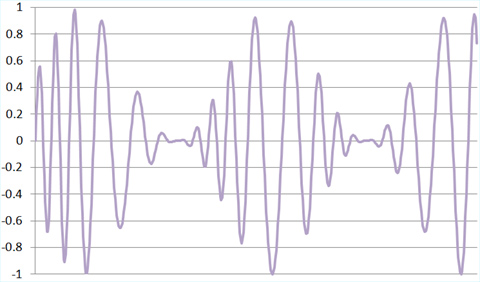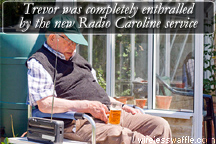Back in December when we discussed the launch of Radio Caroline on 648 kHz and suggested that they were using wider bandwidth AM, Mike left a comment concerning Stereo AM. Stereo AM makes a great article for a post, so here we go!
AM broadcasting in the medium-wave (MW) band is traditionally mono only. Back in the early 1980's four competing technologies were running trials of AM stereo, and in 1988 a solution proposed by Motorola called Compatible-Quadrature Amplitude Modulation (C-QUAM) which had gained significant popularity, was chosen as the de-facto standard in the USA (it was formally adopted in 1993). The word 'compatible' refers to the fact that one of the primary criteria for the solution was that an 'old fashioned' mono AM receiver would not notice any difference when tuned to an AM-stereo signal, that is to say that it would continue to receive a mono signal as if nothing had changed. Thus the stereo signal would remain compatible with mono receivers (note that exactly the same is true of FM stereo).
 The C-QUAM solution used the properties of AM and of FM to do something novel. In an AM waveform (as shown on the right), the information (in this case audio) is imposed onto the transmission frequency (the 'carrier wave') by changing the amount of power transmitted, that is to say, changing the amplitude of the transmission and hence amplitude modulation (AM). At the receiver, only the amplitude of the signal is used to recover the data.
The C-QUAM solution used the properties of AM and of FM to do something novel. In an AM waveform (as shown on the right), the information (in this case audio) is imposed onto the transmission frequency (the 'carrier wave') by changing the amount of power transmitted, that is to say, changing the amplitude of the transmission and hence amplitude modulation (AM). At the receiver, only the amplitude of the signal is used to recover the data.
 For an FM system, the amplitude or power of the transmitter remains the same and only the frequency is varied, hence frequency modulation (FM). In reality, the amplitude of the signal at the receiver will often vary, especially if the receiver is mobile, but as long as the signal that arrives at the receiver is strong enough to overcome any background noise, the receiver will still be able to detect what frequency was being transmitted and recover the original data or audio.
For an FM system, the amplitude or power of the transmitter remains the same and only the frequency is varied, hence frequency modulation (FM). In reality, the amplitude of the signal at the receiver will often vary, especially if the receiver is mobile, but as long as the signal that arrives at the receiver is strong enough to overcome any background noise, the receiver will still be able to detect what frequency was being transmitted and recover the original data or audio.
 What Motorola did was to use both FM and AM at the same time. It is not as easy to see what is going on in the C-QUAM waveform shown on the right, but the principle is fairly straightforward. If you feed this signal into an AM receiver, it will only detect the changes in amplitude and will ignore the changes in frequency completely. If you feed this signal into an FM receiver, the opposite happens and the AM part of the signal is ignored and only the information modulated on the FM part of the signal is decoded. Hence you can send two sets of information at the same time, one using AM and the other FM.
What Motorola did was to use both FM and AM at the same time. It is not as easy to see what is going on in the C-QUAM waveform shown on the right, but the principle is fairly straightforward. If you feed this signal into an AM receiver, it will only detect the changes in amplitude and will ignore the changes in frequency completely. If you feed this signal into an FM receiver, the opposite happens and the AM part of the signal is ignored and only the information modulated on the FM part of the signal is decoded. Hence you can send two sets of information at the same time, one using AM and the other FM.
Compatibility is maintained by sending the Left and Right signals added together on the AM element of the transmission, and the 'stereo difference' (Left minus Right) on the FM part. Thus a mono AM receiver will see no change, but a stereo FM receiver will be able to add the mono and difference signals together to recover the original stereo signal. This is the same principle that applies for stereo FM broadcasting, though the method of transmitting the sum and difference signals are different.
The C-QUAM system is actually a little more complex than the description I have given above, for example, a pilot signal is added into the FM part of the signal to alert receivers that the transmission they are receiving is in C-QUAM, but the logic is in principle the same.
There are lots of videos of C-QUAM AM stereo on YouTube, but the one below is perhaps one of the best illustrations of what it sounds like on-air. It's actually fairly impressive.
So why is it that you've probably never heard of Stereo AM before? Here are some thoughts:
AM broadcasting in the medium-wave (MW) band is traditionally mono only. Back in the early 1980's four competing technologies were running trials of AM stereo, and in 1988 a solution proposed by Motorola called Compatible-Quadrature Amplitude Modulation (C-QUAM) which had gained significant popularity, was chosen as the de-facto standard in the USA (it was formally adopted in 1993). The word 'compatible' refers to the fact that one of the primary criteria for the solution was that an 'old fashioned' mono AM receiver would not notice any difference when tuned to an AM-stereo signal, that is to say that it would continue to receive a mono signal as if nothing had changed. Thus the stereo signal would remain compatible with mono receivers (note that exactly the same is true of FM stereo).
 The C-QUAM solution used the properties of AM and of FM to do something novel. In an AM waveform (as shown on the right), the information (in this case audio) is imposed onto the transmission frequency (the 'carrier wave') by changing the amount of power transmitted, that is to say, changing the amplitude of the transmission and hence amplitude modulation (AM). At the receiver, only the amplitude of the signal is used to recover the data.
The C-QUAM solution used the properties of AM and of FM to do something novel. In an AM waveform (as shown on the right), the information (in this case audio) is imposed onto the transmission frequency (the 'carrier wave') by changing the amount of power transmitted, that is to say, changing the amplitude of the transmission and hence amplitude modulation (AM). At the receiver, only the amplitude of the signal is used to recover the data. For an FM system, the amplitude or power of the transmitter remains the same and only the frequency is varied, hence frequency modulation (FM). In reality, the amplitude of the signal at the receiver will often vary, especially if the receiver is mobile, but as long as the signal that arrives at the receiver is strong enough to overcome any background noise, the receiver will still be able to detect what frequency was being transmitted and recover the original data or audio.
For an FM system, the amplitude or power of the transmitter remains the same and only the frequency is varied, hence frequency modulation (FM). In reality, the amplitude of the signal at the receiver will often vary, especially if the receiver is mobile, but as long as the signal that arrives at the receiver is strong enough to overcome any background noise, the receiver will still be able to detect what frequency was being transmitted and recover the original data or audio. What Motorola did was to use both FM and AM at the same time. It is not as easy to see what is going on in the C-QUAM waveform shown on the right, but the principle is fairly straightforward. If you feed this signal into an AM receiver, it will only detect the changes in amplitude and will ignore the changes in frequency completely. If you feed this signal into an FM receiver, the opposite happens and the AM part of the signal is ignored and only the information modulated on the FM part of the signal is decoded. Hence you can send two sets of information at the same time, one using AM and the other FM.
What Motorola did was to use both FM and AM at the same time. It is not as easy to see what is going on in the C-QUAM waveform shown on the right, but the principle is fairly straightforward. If you feed this signal into an AM receiver, it will only detect the changes in amplitude and will ignore the changes in frequency completely. If you feed this signal into an FM receiver, the opposite happens and the AM part of the signal is ignored and only the information modulated on the FM part of the signal is decoded. Hence you can send two sets of information at the same time, one using AM and the other FM.Compatibility is maintained by sending the Left and Right signals added together on the AM element of the transmission, and the 'stereo difference' (Left minus Right) on the FM part. Thus a mono AM receiver will see no change, but a stereo FM receiver will be able to add the mono and difference signals together to recover the original stereo signal. This is the same principle that applies for stereo FM broadcasting, though the method of transmitting the sum and difference signals are different.
The C-QUAM system is actually a little more complex than the description I have given above, for example, a pilot signal is added into the FM part of the signal to alert receivers that the transmission they are receiving is in C-QUAM, but the logic is in principle the same.
There are lots of videos of C-QUAM AM stereo on YouTube, but the one below is perhaps one of the best illustrations of what it sounds like on-air. It's actually fairly impressive.
So why is it that you've probably never heard of Stereo AM before? Here are some thoughts:
- Though a number of stations (particularly in the USA, Canada, Japan and Australia) did adopt the standard, there may have been insufficient stations on-air for consumers to properly experience the difference.
- The cost of receivers was always higher than mono ones as they were far more complex. This was exacerbated for a while as Motorola held the patents for the system and would have charged manufacturers a handsome fee to adopt it (they were forced to remove such payments in 1993 in the US when the FCC formally adopted the system).
- The quality of transmission of AM stereo, though better than AM mono, was not competitive with FM stereo which, by the time the C-QUAM standard had been adopted, were far more widespread than when the original AM stereo trials began.
- Maybe, and this is just supposition, the types of station on AM were in themselves less popular than the growing FM market, or possibly in some cases the programme material (e.g. talk) was not well suited to stereo.
add comment
( 1910 views )
| permalink
| 



 ( 3 / 50770 )
( 3 / 50770 )




 ( 3 / 50770 )
( 3 / 50770 )
Saturday 27 January, 2018, 09:04 - Spectrum Management, Much Ado About Nothing
Posted by Administrator
It seems that we, here at Wireless Waffle are having a bit of a spate of 'told you so' type events at the moment. Last month we spotted that Vodafone had been rapped over the knuckles for their crafty roaming fee shenanigans. Now we have spotted that Ofcom have been called out to assist drivers who couldn't lock or unlock their cars due to radio interference.Posted by Administrator
 On various occasions we have discussed how straightforward and relatively widespread the jamming of the frequencies used for your car keyfob is. Last time we discussed this it was because some miscreants had latched onto the idea and were stopping people locking their cars so that they could easily break in (more like stroll in) and take whatever they found in the glove compartments, foot wells and boots of the rich and not-so-rich.
On various occasions we have discussed how straightforward and relatively widespread the jamming of the frequencies used for your car keyfob is. Last time we discussed this it was because some miscreants had latched onto the idea and were stopping people locking their cars so that they could easily break in (more like stroll in) and take whatever they found in the glove compartments, foot wells and boots of the rich and not-so-rich. The Ofcom story is even more worrying as it suggests that jamming these devices is far easier than even we though possible. In addition to the car keyfobs we are so keen on discussing, the same frequency range (433 MHz) is also used for a wide variety of other wireless devices including wireless doorbells. These devices are relatively low power (10 milliWatts) and the idea is that they shouldn't interfere with each other as the range of transmission is very small. It seems, however, that a button on one such doorbell got stuck in the 'on' position, meaning it was constantly transmitting. This was enough to stop people in the vacinity locking and unlocking their cars. Thankfully, the brave Ofcom engineers were able to track down the problem and sanity was restored. Hurrah for Ofcom!
The Ofcom story is even more worrying as it suggests that jamming these devices is far easier than even we though possible. In addition to the car keyfobs we are so keen on discussing, the same frequency range (433 MHz) is also used for a wide variety of other wireless devices including wireless doorbells. These devices are relatively low power (10 milliWatts) and the idea is that they shouldn't interfere with each other as the range of transmission is very small. It seems, however, that a button on one such doorbell got stuck in the 'on' position, meaning it was constantly transmitting. This was enough to stop people in the vacinity locking and unlocking their cars. Thankfully, the brave Ofcom engineers were able to track down the problem and sanity was restored. Hurrah for Ofcom!Far be it for us to opine on the implications of this, but taking the earlier example from the BBC in which miscreants were jamming car locks but haven't Ofcom just provided these folk (and others with a similar inclination) with a simple, cheap and undetectable means of achieving the same outcome?
Just get hold of the push-button part of a wireless doorbell, put this in your pocket, and wander around a car park where posh cars park (maybe even buy a hi-viz jacket so it looks as if you are meant to be there). If it's a supermarket car park, collect a few trollies whilst you're waiting. When a particularly rich looking owner appears, go and stand close to their car and as they get out and get ready to press the button on their key to lock it, activate the wireless doorbell button. 'Hey presto', the car won't lock and you will be able to help yourself to their Gucci loafers and other luxury goodies.
From a radio spectrum management and perhaps more specifically a Wireless Telegraphy Act perspective, no law has been broken. From a Theft Act perspective, however, you still stand to be charged (or sit, depending on the layout of the court room).
Thanks Ofcom!

Posted using my gold-plated iPhone X, whilst wearing Gucci loafers and sipping Bollinger RD '85 on my luxury yacht moored in Saint Tropez with my 3 Aston Martins parked alongside.
Saturday 23 December, 2017, 18:01 - Spectrum Management
Posted by Administrator
Back in June of last year, Wireless Waffle discussed the fact that Vodafone had hiked their roaming charges in a number of countries, making even a simple text message cost a fiver or more.Posted by Administrator
 It seems that we were not the only ones to notice this but that the powers that be took a dim view of it as well. As a result, Vodafone has been forced by the telecoms regulator Ofcom to allow its customers to end their contracts early, if they had been duped into the roaming scam.
It seems that we were not the only ones to notice this but that the powers that be took a dim view of it as well. As a result, Vodafone has been forced by the telecoms regulator Ofcom to allow its customers to end their contracts early, if they had been duped into the roaming scam.On the one hand it's hard to feel sorry for Vodafone for sneaking in these additional roaming charges, when it was faced with a total loss of roaming income from anyone going to Europe as a result of European Commission Decision (EU) 2016/2286 which forces all EU mobile operators to abolish roaming charges between Member states, often dubbed the 'roam like at home' decision. On the other hand, it was a pretty underhand move, especially as the only notice that some Vodafone customers had was a text message - and who bothers to read text messages from their operators?
Wednesday 22 November, 2017, 15:31 - Broadcasting, Licensed, Pirate/Clandestine
Posted by Administrator
Posted by Administrator
 Wireless Waffle previously sang the praises of the boat trips to visit the Ross Revenge, the home of former radio pirate, Radio Caroline. We also noted that they had been awarded a licence to operate a 1 kiloWatt transmitter on 648 kHz in the Suffolk and north Essex area.
Wireless Waffle previously sang the praises of the boat trips to visit the Ross Revenge, the home of former radio pirate, Radio Caroline. We also noted that they had been awarded a licence to operate a 1 kiloWatt transmitter on 648 kHz in the Suffolk and north Essex area.Well, it seems the engineering bods on the east coast have managed to get it together, and recently test transmissions on 648 kHz were spotted by a number of listeners, such as a DXer in Humberside who posted the video below on YouTube.
Though you may not be able to interpret the waterfall display shown on the video, what you see is the Radio Caroline signal in the middle. The two bright lines either side represent radio stations on the adjacent frequencies (639 and 657 kHz respectively). Normally, for AM broadcasting, each station would be allowed to occupy half of the bandwidth between its assigned frequency and the adjacent channels, meaining that it would extend +/- 4.5 kHz either side of its centre frequency. It is this limitation they gives medium and long wave broadcasting their characteristic 'muddy' sound, as the limitation in spectrum also restricts the amount of audio bandwidth that can be transmitted.
It's therefore notable that the Radio Caroline transmission on 648 kHz extends far closer to the adjacent frequencies than 4.5 kHz. It appears closer to +/- 6.5 kHz wide (or maybe even more). This would allow the station to transmit a wider audio bandwidth and thus sound a little 'brighter' on-air. Such derogations from the norm are not unusual as the medium wave band has become emptier, as there is more space for stations to spread out and sound better.
As an example, the three audio clips below have been filtered with different bandwidths. Just click on the relevant button to hear the difference (note that this doesn't work in all browsers.
| Audio Bandwidth | Play |
|---|---|
| 15 kHz, stereo (FM Stereo) | |
| 6.5 kHz, mono (extended bandwidth AM) | |
| 4.5 kHz, mono (standard bandwidth AM) |
 Given that of the neighbouring frequencies, the nearest stations on 639 kHz are in the Czech Republic and Spain (previously crowned the queen of medium-wave broadcasting) and on 657 kHz in Spain (again) and North Wales, it seems unlikely that the additional bandwidth being used by Radio Caroline will give any problems and we are sure that listeners will enjoy the cleaner, brighter sound that they will have on-air.
Given that of the neighbouring frequencies, the nearest stations on 639 kHz are in the Czech Republic and Spain (previously crowned the queen of medium-wave broadcasting) and on 657 kHz in Spain (again) and North Wales, it seems unlikely that the additional bandwidth being used by Radio Caroline will give any problems and we are sure that listeners will enjoy the cleaner, brighter sound that they will have on-air.
